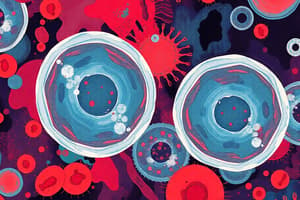Podcast
Questions and Answers
Which of the following diseases can result in neutrophilia?
Which of the following diseases can result in neutrophilia?
- Hairy cell leukemia
- Tuberculosis (correct)
- Rheumatoid arthritis (correct)
- Aplastic anemia
What condition is associated with a lack of leukocyte adhesion proteins, leading to increased susceptibility to infections?
What condition is associated with a lack of leukocyte adhesion proteins, leading to increased susceptibility to infections?
- Leukocyte Adhesion Deficiency (correct)
- Pelger-Huet Anomaly
- Chediak-Higashi Syndrome
- Chronic Granulomatous Disease
In which condition do neutrophils retain the ability to phagocytose but are unable to kill microorganisms?
In which condition do neutrophils retain the ability to phagocytose but are unable to kill microorganisms?
- Myelodysplastic Syndrome
- Chronic Granulomatous Disease (correct)
- Pelger-Huet Anomaly
- Chediak-Higashi Syndrome
Which of the following is NOT a potential cause of monocytopenia?
Which of the following is NOT a potential cause of monocytopenia?
What characteristic shape do neutrophils exhibit in Pelger-Huet Anomaly?
What characteristic shape do neutrophils exhibit in Pelger-Huet Anomaly?
Which autoimmune disease is commonly associated with neutrophilia?
Which autoimmune disease is commonly associated with neutrophilia?
What type of genetic mutation is associated with Chediak-Higashi Syndrome?
What type of genetic mutation is associated with Chediak-Higashi Syndrome?
Which of the following is a characteristic of Chronic Granulomatous Disease?
Which of the following is a characteristic of Chronic Granulomatous Disease?
Basophilia can be associated with which of the following?
Basophilia can be associated with which of the following?
Which is a common treatment for conditions causing monocytopenia?
Which is a common treatment for conditions causing monocytopenia?
What is a common cause of absolute lymphocytosis?
What is a common cause of absolute lymphocytosis?
Which condition is NOT associated with relative lymphocytosis?
Which condition is NOT associated with relative lymphocytosis?
What does the term neutrophilia refer to?
What does the term neutrophilia refer to?
Infectious mononucleosis is primarily caused by which virus?
Infectious mononucleosis is primarily caused by which virus?
Which clinical feature is characteristic of infectious mononucleosis?
Which clinical feature is characteristic of infectious mononucleosis?
What is the normal range of leukocytes in peripheral circulation?
What is the normal range of leukocytes in peripheral circulation?
What is the blood picture typically seen in infectious mononucleosis?
What is the blood picture typically seen in infectious mononucleosis?
Which type of white blood cell is primarily affected in neutrophilia?
Which type of white blood cell is primarily affected in neutrophilia?
Which of the following is a cause of relative lymphocytosis?
Which of the following is a cause of relative lymphocytosis?
What is a common threshold for defining neutrophilia?
What is a common threshold for defining neutrophilia?
Which factor is NOT typically related to absolute lymphocytosis?
Which factor is NOT typically related to absolute lymphocytosis?
Which of the following conditions could lead to neutrophilia?
Which of the following conditions could lead to neutrophilia?
What is the clinical significance of diagnosing neutrophilia?
What is the clinical significance of diagnosing neutrophilia?
Which of the following statements about infectious mononucleosis is true?
Which of the following statements about infectious mononucleosis is true?
Monocytosis is often associated with what condition?
Monocytosis is often associated with what condition?
Neutrophilia can be associated with which of the following types of leukocyte disorders?
Neutrophilia can be associated with which of the following types of leukocyte disorders?
Which of the following is NOT a cause of absolute lymphocytosis?
Which of the following is NOT a cause of absolute lymphocytosis?
In neutrophilia, which of the following could be a potential diagnostic strategy?
In neutrophilia, which of the following could be a potential diagnostic strategy?
Which type of leukocytosis specifically involves an increase in neutrophils?
Which type of leukocytosis specifically involves an increase in neutrophils?
Which of the following is a severe form of neutropenia?
Which of the following is a severe form of neutropenia?
What physiological condition can lead to neutrophilia?
What physiological condition can lead to neutrophilia?
Which drug is known to increase neutrophil release from the bone marrow?
Which drug is known to increase neutrophil release from the bone marrow?
Which condition is a common cause of reactive neutrophilia?
Which condition is a common cause of reactive neutrophilia?
What is a potential cause of neutrophilia associated with metabolic diseases?
What is a potential cause of neutrophilia associated with metabolic diseases?
In which type of leukemia could neutrophilia be frequently observed?
In which type of leukemia could neutrophilia be frequently observed?
What is a common clinical manifestation seen alongside reactive neutrophilia?
What is a common clinical manifestation seen alongside reactive neutrophilia?
Which of these is NOT a characteristic of physiological neutrophilia?
Which of these is NOT a characteristic of physiological neutrophilia?
Which immune response is closely linked to the phenomenon of neutrophilia?
Which immune response is closely linked to the phenomenon of neutrophilia?
What condition can cause metabolic disturbances leading to neutrophilia?
What condition can cause metabolic disturbances leading to neutrophilia?
Which of the following conditions can be exacerbated by neutrophilia?
Which of the following conditions can be exacerbated by neutrophilia?
Flashcards
Neutropenia Causes
Neutropenia Causes
A condition with low neutrophil counts, caused by accelerated removal, increased destruction, autoimmune issues, or bone marrow problems.
Acquired Neutropenia
Acquired Neutropenia
Neutropenia developed later in life due to various factors like inflammation, infections, drugs, radiation, or autoimmune disorders.
Felty's Syndrome
Felty's Syndrome
A form of rheumatoid arthritis where the spleen destroys neutrophils.
Neutrophilia
Neutrophilia
Signup and view all the flashcards
Reactive Neutrophilia
Reactive Neutrophilia
Signup and view all the flashcards
Eosinophilia Causes
Eosinophilia Causes
Signup and view all the flashcards
Neutropenia Congenital Causes
Neutropenia Congenital Causes
Signup and view all the flashcards
Neutrophilia Physiological Conditions
Neutrophilia Physiological Conditions
Signup and view all the flashcards
Eosinophilia Diagnosis
Eosinophilia Diagnosis
Signup and view all the flashcards
Neutrophilia - Drug/Toxic Causes
Neutrophilia - Drug/Toxic Causes
Signup and view all the flashcards
Leukocytosis
Leukocytosis
Signup and view all the flashcards
Leukopenia
Leukopenia
Signup and view all the flashcards
WBC Function
WBC Function
Signup and view all the flashcards
Phagocytosis
Phagocytosis
Signup and view all the flashcards
Margination
Margination
Signup and view all the flashcards
Diapedesis
Diapedesis
Signup and view all the flashcards
Normal WBC Range
Normal WBC Range
Signup and view all the flashcards
Agranulocytosis
Agranulocytosis
Signup and view all the flashcards
Monocytopenia Causes
Monocytopenia Causes
Signup and view all the flashcards
Basophilia Causes
Basophilia Causes
Signup and view all the flashcards
Pelger-Huet Anomaly
Pelger-Huet Anomaly
Signup and view all the flashcards
Chediak-Higashi Syndrome
Chediak-Higashi Syndrome
Signup and view all the flashcards
Chronic Granulomatous Disease (CGD)
Chronic Granulomatous Disease (CGD)
Signup and view all the flashcards
Leukocyte Adhesion Deficiency (LAD)
Leukocyte Adhesion Deficiency (LAD)
Signup and view all the flashcards
Qualitative WBC Disorder
Qualitative WBC Disorder
Signup and view all the flashcards
White blood cells
White blood cells
Signup and view all the flashcards
Infectious causes of abnormal WBC counts
Infectious causes of abnormal WBC counts
Signup and view all the flashcards
Lymphocytosis causes
Lymphocytosis causes
Signup and view all the flashcards
Acute Viral Infections
Acute Viral Infections
Signup and view all the flashcards
Chronic intracellular bacterial infections
Chronic intracellular bacterial infections
Signup and view all the flashcards
Chronic lymphocytic leukemia
Chronic lymphocytic leukemia
Signup and view all the flashcards
Relative Lymphocytosis
Relative Lymphocytosis
Signup and view all the flashcards
Infectious Mononucleosis
Infectious Mononucleosis
Signup and view all the flashcards
Epstein-Barr virus
Epstein-Barr virus
Signup and view all the flashcards
Monocytosis
Monocytosis
Signup and view all the flashcards
Clinical features of IM
Clinical features of IM
Signup and view all the flashcards
Study Notes
Alterations in White Blood Cells
- White blood cells (WBCs) are crucial for defending against disease, primarily operating outside the bloodstream.
- WBCs exhibit key functions including margination, rolling, adhesion, transmigration (diapedesis), and chemotaxis.
Hematopoiesis
- Hematopoiesis is the process of blood cell formation.
- The process begins with a pluripotent stem cell, which differentiates into myeloid and lymphoid stem cells.
- Myeloid stem cells generate granulocytes, megakaryocytes, and erythrocytes.
- Lymphoid stem cells generate B cells and T cells which mature into plasma cells and various T-cells.
- Common Fate Unit (CFU) cells are intermediates in the development process
Functions of WBCs
- WBCs primarily function to protect against disease.
- They actively work outside the bloodstream.
- WBCs participate in key processes like margination, rolling, and adhesion, and transmigration.
- WBCs use chemotaxis to navigate toward infection sites.
- Phagocytosis involves recognition, engulfment, killing, and digestion of pathogens by neutrophils and monocytes (active phagocytes)
Lysosomal Constituents
- Lysosomes contain enzymes for breaking down foreign particles.
- Primary lysosomes (azurophilic, non-specific) contain myeloperoxidase, lysozyme (bacteria targeted), and acid hydrolases.
- Secondary lysosomes (specific) contain lactoferrin, lysozyme (again bacteria), alkaline phosphatase, and collagenase.
Benign Disorders of White Blood Cells
- Benign white blood cell disorders can be categorized as either qualitative (morphological or functional changes) or quantitative (changes in number).
Quantitative Disorders of White Blood Cells
- Leukocytosis involves an increased number of white blood cells.
- The normal range of leukocytes in peripheral blood is 4000 to 11,000/μL.
- Leukopenia describes a reduced number of white blood cells.
- Specific types of leukopenia include neutropenia (low neutrophils) and lymphopenia (low lymphocytes).
- Related terms include leukocytosis, neutrophilia, eosinophilia, basophilia, lymphocytosis, monocytosis and their respective decreased counterparts.
Neutropenia
- Neutropenia is specifically a reduced neutrophil count (less than 1500 cells/μL).
- Agranulocytosis denotes severe neutropenia (neutrophil count less than 200 cells/μL).
- Neutropenia has congenital (e.g., Kostmann's syndrome) and acquired causes (e.g., accelerated removal, increased destruction, drug-induced granulocytopenia, irradiation, autoimmune disorders, splenomegaly).
- Acquired neutropenia includes various conditions like Felty's syndrome, neoplasms, alcoholism, and nutritional deficiencies (folate, vitamin B12, iron, copper).
- Aplastic anemia and idiopathic neutropenia are also included.
Neutrophilia
- Physiological causes include newborns, pregnancy, labor, postpartum, and post-exercise.
- Drug-induced neutrophilia can be caused by corticosteroids.
- Other causes include acute poisoning with heavy metals (Hg) and some venoms.
- Reactive neutrophilia results from increased neutrophil release from bone marrow to accommodate high tissue affinity, often accompanied by leukocyte formula deviation ("leukemoid reaction").
- Metabolic and endocrine diseases (diabetic ketoacidosis, acute renal failure, acute gout) and some malignant hematologic diseases (CGL, PV, CMML) are also potential causes
Eosinophilia
- Eosinophilia is an increased blood eosinophil count.
- Potential causes include allergic diseases (asthma, allergic rhinitis, eczema, atopic dermatitis), parasitic infections, fungal and other infections, tuberculosis, and hematologic and non-hematologic malignancies.
Lymphocytosis
- Lymphocytosis is an elevated lymphocyte count.
- Absolute lymphocytosis has causes like acute viral infections (infectious mononucleosis, hepatitis, cytomegalovirus), other acute infections (pertussis), protozoal infections (toxoplasmosis), and chronic intracellular bacterial infections (tuberculosis, brucellosis), and chronic lymphocytic leukemia.
- Relative lymphocytosis causes include age less than two years, acute viral infections, connective tissue diseases, splenomegaly with splenic sequestration of granulocytes, exercise, and stress.
- Infectious mononucleosis, caused by Epstein-Barr virus, is characterized by virus infection of epithelial and B cells; saliva from infected persons is the chief mode of transmission. The condition often does not cause illness in children below age 10 and confers lifelong immunity afterward.
Monocytosis
- Monocytosis is an elevated level of monocytes.
- Chronic inflammation, infections (tuberculosis, brucellosis), autoimmune diseases (systemic lupus erythematosus, rheumatoid arthritis), malignancies (Hodgkin's disease, certain leukemias), and recovery from neutropenia or acute infections are frequent causes.
Monocytopenia
- Monocytopenia is characterized by low monocyte levels.
- Potential causes include acute infections, stress, aplastic anemia, hairy cell leukemia, acute myeloid leukemia, treatment with myelotoxic drugs, and treatment with glucocorticoids.
Basophilia
- Basophilia, an increased basophil count, could result from a surgery complication (e.g., splenectomy), infectious disorders (Influenza, Chickenpox), infected organ sites (abscesses), inflammatory disorders, and neoplastic disorders (acute myeloid leukemia, Hodgkin's disease).
- Further causes of basophilia include allergic/collagen autoimmune disorders, congenital/developmental disorders, hereditary/familial/genetic disorders (e.g., spherocytosis), vegetative/autonomic/endocrine disorders (e.g., hypothyroidism), a leukemoid reaction, drug reactions, and foreign protein injection.
Qualitative Disorders of White Blood Cells
- Qualitative disorders involve changes in the form or function of white blood cells.
- Pelger-Huet anomaly is an inherited genetic mutation (sometimes acquired) causing abnormal neutrophil shapes (bilobed, peanut, or dumbbell).
- Chediak-Higashi syndrome (genetic disorder) presents with abnormal large irregular granules, impaired lysosomal digestion of bacteria, and association with pigment disorders and blood disorders.
- These abnormalities are usually associated with an increased risk of infection.
Chronic Granulomatous Disease (CGD)
- In Chronic granulomatous disease (CGD), abnormal neutrophils phagocytose microorganisms but cannot kill them due to a lack of respiratory burst and peroxidase production.
Leukocyte Adhesion Deficiency (LAD)
- Leukocyte adhesion deficiency (LAD) is an autosomal recessive disorder impacting leukocyte cell-surface adhesion proteins (integrins), specifically the CD11/CD18 complex.
- Defective adhesion to endothelial cells, chemotaxis, C3bi-mediated phagocytosis, particle-triggered respiratory burst activation, and degranulation are characteristic of this condition.
- Common clinical features include frequent bacterial and fungal infections, lack of pus formation, and delayed umbilical cord separation, along with persistent leukocytosis. Diagnosis involves flow cytometry analysis of neutrophil CD11/CD18 levels.
Studying That Suits You
Use AI to generate personalized quizzes and flashcards to suit your learning preferences.




